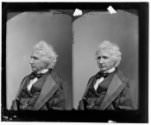Sixth version, acquired in Italy by Edwin W. Stoughton, 1869
Sixth version, acquired in Italy by Edwin W. Stoughton, 1869
E. W. Stoughton (1818–82) reportedly visited Powers in 1869 and agreed to purchase the final version of The Greek Slave, which stood in Powers’s studio. Stoughton was a patent lawyer practicing in New York and a friend and advocate of Ulysses Grant. In a letter dated November 1869, Powers noted: “I regard the substitution of the regular manacles for the rather ornamental than real chain in former repetitions of the ‘Greek Slave’ as a decided advantage, since it distinguishes it from all others, and is really more to the purpose.”[1] This points to Powers’s intention to make an explicit anti-slavery statement while highlighting his ongoing concern to make each statue an original work.
[1] Powers to Stoughton, November 26, 1869, Hiram Powers Papers, box 9, folder 13, frame 10, Archives of American Art, Smithsonian Institution.
